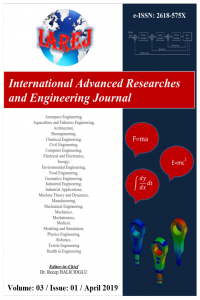Abstract
References
- 1. Scrivener, K.L. and A. Nonat, Hydration of cementitious materials, present and future. Cement and concrete research, 2011. 41(7): p. 651-665.
- 2. Rostami, M. and K. Behfarnia, The effect of silica fume on durability of alkali activated slag concrete. Construction and Building Materials, 2017. 134: p. 262-268.
- 3. Duxson, P., et al., The role of inorganic polymer technology in the development of ‘green concrete’. Cement and Concrete Research, 2007. 37(12): p. 1590-1597.
- 4. Douglas, E. and Brandstetr, J., A preliminary study on the alkali activation of ground granulated blast-furnace slag. Cement and Concrete Research, 1990. 20(5): p. 746-756.
- 5. Brough, A. R., and Atkinson, A., Sodium silicate-based, alkali-activated slag mortars: Part I. Strength, hydration and microstructure. Cement and Concrete Research, 2002, 32(6): p. 865-879.
- 6. Ozturk, M., Bankır, M. B., Bolukbası, O. S., and Sevım, U.K. Alkali Activation of Electric Arc Furnace Slag: Mechanical Properties and Micro Analyzes. Journal of Building Engineering, in press, 2018.
- 7. Chi, M., Effects of dosage of alkali-activated solution and curing conditions on the properties and durability of alkali-activated slag concrete. Construction and Building Materials, 2012, 35, p. 240-245.
- 8. Oh, J. E., Monteiro, P. J., Jun, S. S., Choi, S. and Clark, S. M. The evolution of strength and crystalline phases for alkali-activated ground blast furnace slag and fly ash-based geopolymers. Cement and Concrete Research,2010,40(2):p.189-196.
Investigation of mechanical and microstructural performance of alkali activated electrical arc furnace slag mortars
Abstract
The production of Portland cement, resulting in the release
of CO2 gas, excessive energy and natural resource consumption, has
led to search for alternative materials with similar physical and mechanical properties
to the Portland cement of the scientific community. Geopolymers as alternative
to conventional cement have a great potential for use in terms of their
mechanical and durability properties. For this reason, it is necessary to
investigate the usability of a new material alternative to cement, to reduce
the environmental impact and for the disposal of Electric Arc Furnace Slag
(EAFS), which is produced in large quantities in the primary target world and
in Turkey and which causes storage space bottleneck. For this purpose, the
mechanical and microstructure of the activated EAFS exposed to different curing
conditions at three different sodium concentrations with a silicate module was
investigated. When the results are examined, it is obvious that the strength
increases with the increase of the sodium concentration. In addition, the
literature on which alkali activation of EAFS has been added for the first
time.
References
- 1. Scrivener, K.L. and A. Nonat, Hydration of cementitious materials, present and future. Cement and concrete research, 2011. 41(7): p. 651-665.
- 2. Rostami, M. and K. Behfarnia, The effect of silica fume on durability of alkali activated slag concrete. Construction and Building Materials, 2017. 134: p. 262-268.
- 3. Duxson, P., et al., The role of inorganic polymer technology in the development of ‘green concrete’. Cement and Concrete Research, 2007. 37(12): p. 1590-1597.
- 4. Douglas, E. and Brandstetr, J., A preliminary study on the alkali activation of ground granulated blast-furnace slag. Cement and Concrete Research, 1990. 20(5): p. 746-756.
- 5. Brough, A. R., and Atkinson, A., Sodium silicate-based, alkali-activated slag mortars: Part I. Strength, hydration and microstructure. Cement and Concrete Research, 2002, 32(6): p. 865-879.
- 6. Ozturk, M., Bankır, M. B., Bolukbası, O. S., and Sevım, U.K. Alkali Activation of Electric Arc Furnace Slag: Mechanical Properties and Micro Analyzes. Journal of Building Engineering, in press, 2018.
- 7. Chi, M., Effects of dosage of alkali-activated solution and curing conditions on the properties and durability of alkali-activated slag concrete. Construction and Building Materials, 2012, 35, p. 240-245.
- 8. Oh, J. E., Monteiro, P. J., Jun, S. S., Choi, S. and Clark, S. M. The evolution of strength and crystalline phases for alkali-activated ground blast furnace slag and fly ash-based geopolymers. Cement and Concrete Research,2010,40(2):p.189-196.
Details
| Primary Language | English |
|---|---|
| Journal Section | Research Articles |
| Authors | |
| Publication Date | April 15, 2019 |
| Submission Date | April 20, 2018 |
| Acceptance Date | November 27, 2018 |
| Published in Issue | Year 2019 Volume: 3 Issue: 1 |


